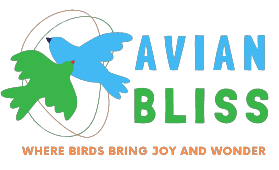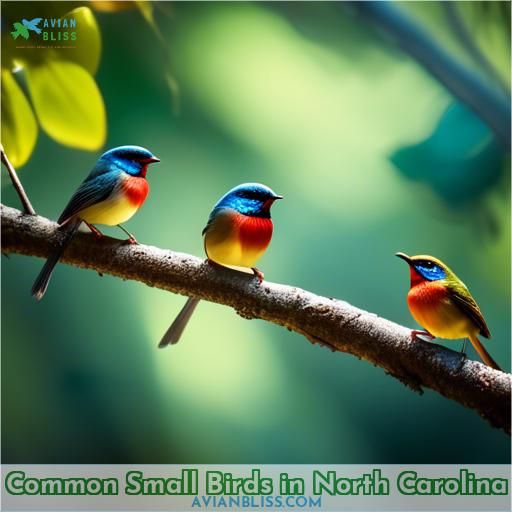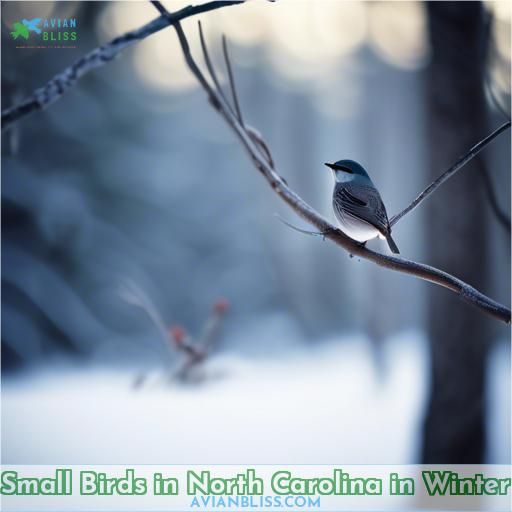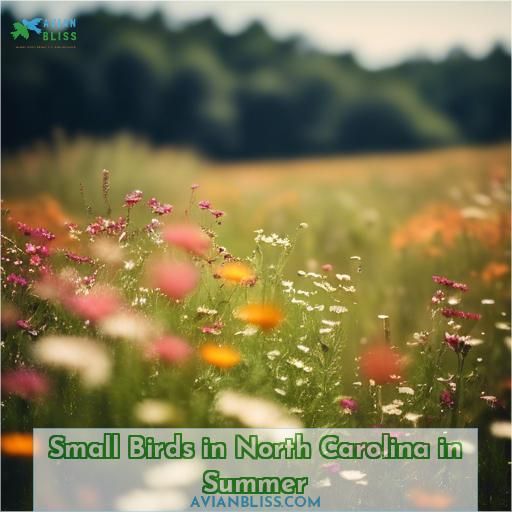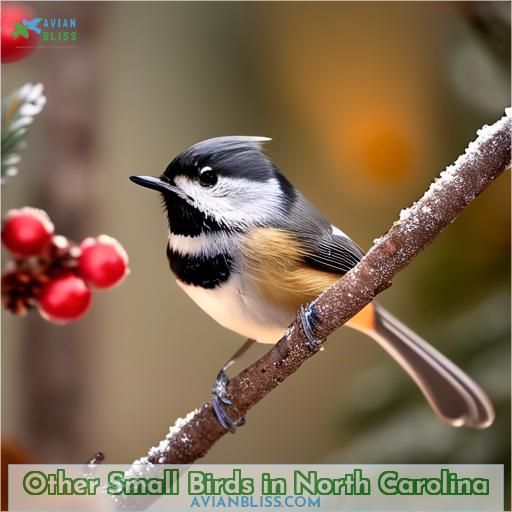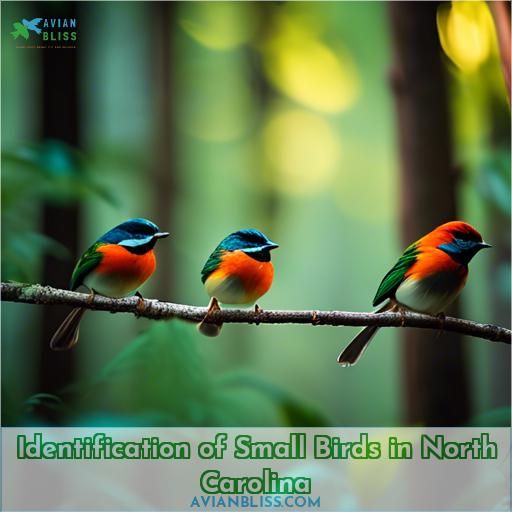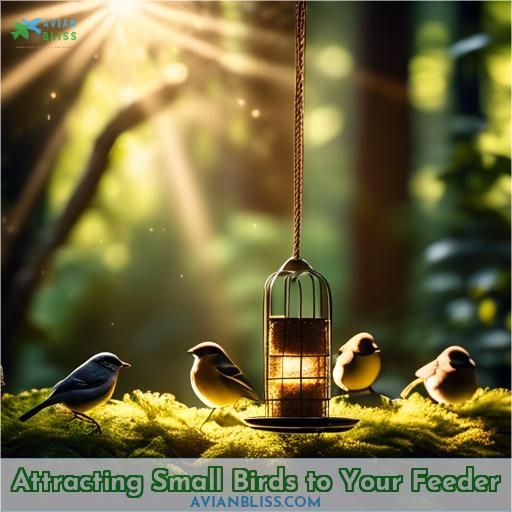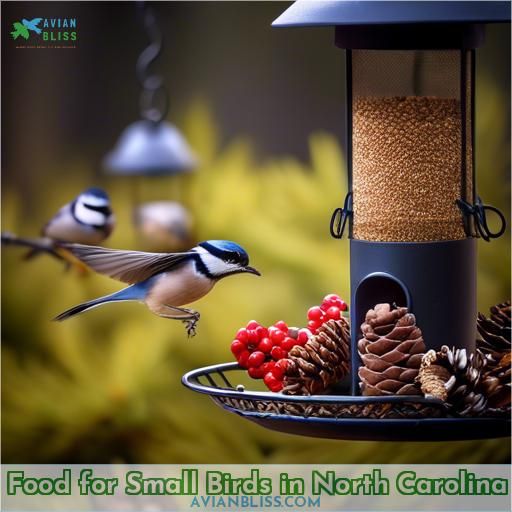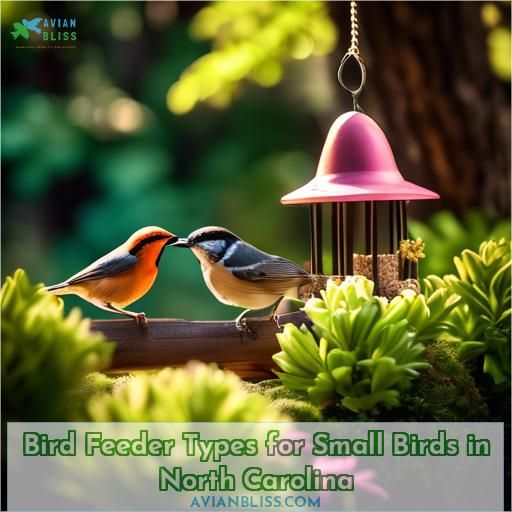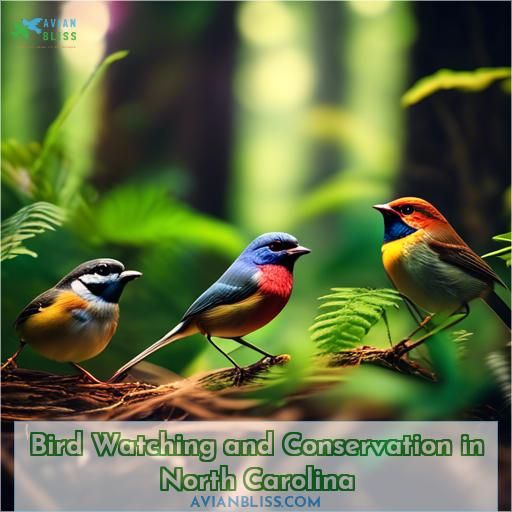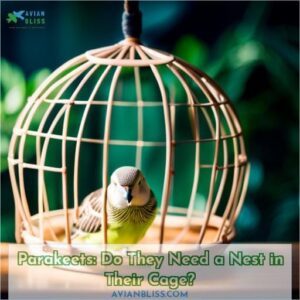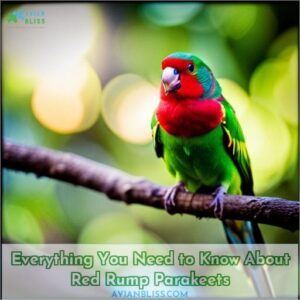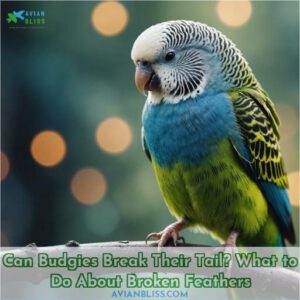This site is supported by our readers. We may earn a commission, at no cost to you, if you purchase through links.
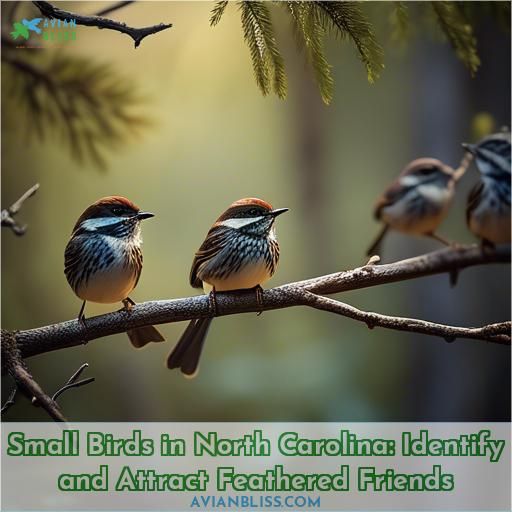 Fluttering jewels, small birds in North Carolina enchant with vibrant plumage and lively antics.
Fluttering jewels, small birds in North Carolina enchant with vibrant plumage and lively antics.
You’ll discover resilient songbirds decorating backyards, parks, and nature trails.
This comprehensive guide unveils identifying traits, behavior patterns, and proven tactics to attract these feathered marvels.
Embrace nature’s delightful melodies while fostering a nurturing sanctuary.
Immerse yourself in the captivating world of North Carolina’s diminutive avian residents – an experience awaiting your eager eyes and ears.
Table Of Contents
- Key Takeaways
- Small Birds in North Carolina
- Common Small Birds in North Carolina
- Small Birds in North Carolina in Winter
- Small Birds in North Carolina in Summer
- Other Small Birds in North Carolina
- Identification of Small Birds in North Carolina
- Attracting Small Birds to Your Feeder
- Food for Small Birds in North Carolina
- Bird Feeder Types for Small Birds in North Carolina
- Bird Watching and Conservation in North Carolina
- Frequently Asked Questions (FAQs)
- Conclusion
Key Takeaways
- Small birds in North Carolina are found in various habitats, including forests, grasslands, wetlands, and urban environments.
- Many small birds in North Carolina are migratory, traveling between their breeding grounds in North America and their wintering grounds in Central and South America.
- Small birds in North Carolina typically build their nests in trees or shrubs, often using materials like grass, twigs, and animal hair.
- To attract small birds to your feeder, you can provide a variety of foods, including seeds, nuts, and fruits, and use different types of feeders like tube feeders, platform feeders, hopper feeders, and suet feeders.
Small Birds in North Carolina
Small birds are a delight to observe in North Carolina, with a diverse range of species that can be found throughout the state. These birds aren’t only visually appealing but also play a crucial role in the ecosystem, contributing to pollination, seed dispersal, and pest control. In this article, we’ll discuss the identification and attraction of small birds in North Carolina, focusing on their habitats, migration patterns, nesting habits, bird song, and bird photography.
Habitats: Small birds in North Carolina can be found in various habitats, including forests, grasslands, wetlands, and urban environments. Some common small bird habitats in North Carolina include:
- Forests: Small birds like the Carolina Chickadee, Tufted Titmouse, and Eastern Bluebird are commonly found in forests, where they feed on insects, seeds, and fruits.
- Grasslands: Birds like the Chipping Sparrow and American Goldfinch are adapted to open grasslands and fields, where they forage for seeds and insects.
- Wetlands: Small birds such as the Mourning Dove and Red-winged Blackbird can be found in wetland habitats, where they feed on seeds, insects, and other aquatic organisms.
- Urban environments: Small birds like the House Sparrow and European Starling have adapted to living in urban areas, where they can find food and nesting sites among humans.
Migration Patterns: Many small birds in North Carolina are migratory, traveling between their breeding grounds in North America and their wintering grounds in Central and South America. Some common migratory small birds in North Carolina include the Chipping Sparrow, Eastern Bluebird, and Northern Mockingbird.
Nesting Habits: Small birds in North Carolina typically build their nests in trees or shrubs, often using materials like grass, twigs, and animal hair. Some common nesting sites for small birds include:
- Trees: Birds like the Carolina Chickadee and Tufted Titmouse often nest in trees, where they can be protected from predators and have easy access to food sources.
- Shrubs: Small birds like the House Sparrow and American Goldfinch often nest in shrubs, where they can be more visible and accessible to humans.
- Buildings: Small birds like the House Sparrow and European Starling have adapted to nesting in the eaves and crevices of buildings, where they can be protected from predators and have easy access to food sources.
Bird Song: Small birds in North Carolina are known for their diverse range of songs and calls, which can be used to identify different species. Some common small birds in North Carolina and their songs include:
- Northern Cardinal: A distinctive, loud, and clear whistle.
- Carolina Wren: A loud, melodic, and varied song.
- American Robin: A melodic, flute-like song.
- Blue Jay: A loud, sharp, and distinctive jay call.
- Eastern Bluebird: A clear, whistling song.
Bird Photography: Photographing small birds in North Carolina can be a rewarding experience, as they’re often colorful and active. Some tips for bird photography include:
- Use a telephoto lens: A telephoto lens with a focal length of at least 200mm will allow you to get close to the birds without disturbing them.
- Use a tripod: A tripod will help stabilize your camera and prevent camera shake, which can be a problem when using a telephoto lens.
- Use natural light: Natural light is often the best option for bird photography, as it can provide soft, even lighting.
- Be patient: Small birds can be shy and elusive, so it may take some time to get the perfect shot.
Attracting Small Birds to Your Feeder: Small birds in North Carolina can be attracted to bird feeders using a variety of foods, including seeds, nuts, and fruits. Some common foods for attracting small birds include:
- Sunflower seeds: A popular choice for attracting a variety of small birds, including finches, sparrows, and buntings.
- Cracked corn: A good option for attracting ground-feeding birds like doves and sparrows.
- Suet: A high-fat food source that’s popular with woodpeckers and other insect-eating birds.
- Fruits: Small birds like robins and bluebirds are attracted to fruits like berries and grapes.
Bird Feeder Types: There are many types of bird feeders available for attracting small birds in North Carolina, including:
- Tube feeders: A popular choice for attracting small birds like finches and sparrows.
- Platform feeders: Ideal for ground-feeding birds like doves and sparrows.
- Hopper feeders: A good option for attracting a variety of small birds, including finches, sparrows, and buntings.
- Suet feeders: Designed for attracting woodpeckers and other insect-eating birds.
Bird Watching and Conservation in North Carolina: Bird watching is a popular activity in North Carolina, with many birding hotspots throughout the state. Some popular birding locations include:
- Cape Hatteras National Seashore: Home to a variety of migratory birds, including shorebirds, waterbirds, and songbirds.
- Piedmont Bird Club: A nonprofit organization dedicated to the study and conservation of birds in the Piedmont region of North Carolina.
- Duke Farms: A 3,200-acre nature reserve in Hillsborough, North Carolina, that’s home to a variety of bird species, including woodpeckers, owls, and hawks.
In conclusion, small birds in North Carolina are a diverse and fascinating group of birds that can be found in various habitats throughout the state. By understanding their habitats, migration patterns, nesting habits, and bird song, you can better appreciate these birds and enjoy the opportunity to photograph and observe them. Additionally, by providing food and shelter through bird feeders and conservation efforts, you can help support the health and well-being of these important birds.
Common Small Birds in North Carolina
North Carolina is home to a diverse array of small birds that can be found in various habitats across the state. Some of the most common small birds in North Carolina include the Northern Cardinal, Eastern Bluebird, Carolina Wren, White-breasted Nuthatch, and Song Sparrow. These birds play a vital role in the ecosystem and are a delight to observe.
To identify these small birds, pay attention to their vocalizations. For example, the Northern Cardinal has a distinctive whistle, while the Eastern Bluebird has a clear, melodic song. The Carolina Wren has a varied repertoire of songs and calls, and the White-breasted Nuthatch has a loud, distinctive yank-yank call.
Conservation strategies are crucial for the protection of these small birds. Climate change poses a significant threat to their habitats, and winter feeding is essential for their survival. Providing food, such as seeds and suet, can help sustain small birds during the colder months.
In addition to the birds mentioned, the state also hosts other small birds like the American Robin, House Finch, and Northern Mockingbird. These birds can be found in various habitats, from forests to towns, and are integral to the ecological balance of North Carolina.
By understanding the habitats and vocalizations of these small birds, we can appreciate their beauty and play a role in their conservation.
Small Birds in North Carolina in Winter
As the temperatures drop and days grow shorter, many birds in North Carolina begin their journey to warmer climates. Some species, like the Ruby-throated Hummingbird, migrate to Mexico and Central America, while others, such as the American Goldfinch, move to the southern United States.
Identifying Winter Plumage:
During winter, many birds develop different plumage colors to blend in with their surroundings. For example, the Northern Mockingbird’s plumage becomes more subdued, while the Yellow-rumped Warbler‘s bright yellow patches become more prominent.
Winter Bird Feeding:
Providing food for winter birds is crucial, as natural food sources may be scarce. Offer seeds, suet, and fruit, and clean feeders regularly to prevent disease spread.
Birdwatching for Winter Species:
Winter is an excellent time for birdwatching, as many birds are more visible due to the lack of foliage. Look for species like the White-throated Sparrow, Eastern Phoebe, and Dark-eyed Junco.
Winter Bird Photography:
Winter birds can provide stunning photography opportunities. Be patient and use a camera with a fast shutter speed to capture their movements.
In summary, winter in North Carolina is a crucial time for birds, as they migrate, adapt their plumage, and rely on human-provided food sources. By understanding these changes and taking steps to support winter birds, we can help maintain a healthy ecosystem.
Small Birds in North Carolina in Summer
In the summer months, North Carolina’s bird population is vibrant and diverse, with various species inhabiting the state’s diverse habitats.
- Summer habitats: Small birds, such as warblers and flycatchers, thrive in the lush, green forests and woodlands of North Carolina. These habitats provide ample food sources and nesting sites for these birds.
- Breeding seasons: Many small birds in North Carolina, like the Northern Parula and Eastern Wood-pewee, breed during the summer months. This is when they build their nests and raise their young.
- Migratory patterns: Some small birds, like the Pine Warbler and Northern Parula, are migratory and return to North Carolina during the summer season. They travel from their wintering grounds in the south to breed and raise their young in the state.
- Nesting sites: Small birds in North Carolina use a variety of nesting sites, including trees, shrubs, and even on the ground in marshes. Platform stick nests are built by both sexes and provide shelter for the birds and their young.
- Food sources: During the summer, small birds in North Carolina feed on a variety of insects, fruits, and seeds. This diverse diet ensures that they’ve the necessary nutrients for breeding and raising their young.
To attract small birds to your feeder during the summer, consider providing a variety of seeds, such as sunflower seeds and millet. Offering fresh water and providing shelter, like birdhouses or nesting boxes, can also help attract these birds to your backyard.
Other Small Birds in North Carolina
In the realm of small birds in North Carolina, there’s a whole host of feathered friends that you mightn’t have considered yet. These birds, while not as common as others, are still an integral part of the avian community in the state.
One such bird is the Ruby-crowned Kinglet, a small bird with a distinctive red crown. These birds are often found in wooded habitats, and they’re known for their lively, flitting movements. Another bird to keep an eye out for is the Ruby-throated Hummingbird, which is the smallest bird in North Carolina. These birds aren’t only known for their vibrant colors but also for their incredible ability to hover in mid-air.
Small birds in North Carolina also have their own unique songs. The Blue Jay, for example, has a loud, distinctive call that can be heard from far away. The Mourning Dove, on the other hand, has a gentle, cooing song that’s often mistaken for a pigeon.
When it comes to small bird migration, the American Crow is a bird to watch. These birds are known for their large flocks and their ability to travel long distances.
Small bird predators are also a concern in North Carolina. The American Crow, for instance, is a predator of small birds’ eggs and nestlings. The Blue Jay, on the other hand, is known to eat small birds, especially during the nesting season.
To attract these small birds to your feeder, consider offering a variety of seeds and suet cakes. Bird feeders with small perches and a protective roof can also help. And remember, patience is key when it comes to bird watching. It’s not merely about seeing the birds, but also about understanding their habits and behaviors.
Identification of Small Birds in North Carolina
Welcome bird enthusiasts! Today, we’re diving into the fascinating world of small birds in North Carolina. With over 483 species native to the state, there’s a lot to explore. Let’s start by discussing the identification of these small, feathered friends.
Small birds in North Carolina come in a variety of sizes, shapes, and color patterns. Some of the most common small birds include the Northern Cardinal, Carolina Chickadee, Tufted Titmouse, and American Goldfinch. These birds can be identified by their distinctive features such as the cardinal’s bright red plumage, the chickadee’s black and white stripes, the titmouse’s crest, and the goldfinch’s yellow body and black face.
Habitat preferences play a significant role in identifying small birds. For example, the Carolina Chickadee and Tufted Titmouse are often found in forests, while the American Goldfinch prefers open fields and meadows. Understanding these habitat preferences can help you spot these birds in their natural environments.
Nesting behaviors can also be a useful identifier. For instance, the Northern Cardinal builds a cup-shaped nest in trees or shrubs, while the American Goldfinch nests in a variety of locations, including trees, shrubs, and even on the ground.
Vocalizations are another key identifier. The Northern Cardinal has a distinctive whistle sound, while the Tufted Titmouse has a peter-peter-peter call. The American Goldfinch has a high-pitched sweet song.
Foraging habits can also help identify small birds. Some, like the American Goldfinch, primarily feed on seeds, while others, like the Tufted Titmouse, eat insects, seeds, and fruit.
In conclusion, identifying small birds in North Carolina involves understanding their size variation, habitat preferences, nesting behaviors, vocalizations, and foraging habits. With a bit of knowledge and observation, you’ll be able to spot these delightful creatures in your backyard or on your next nature walk.
Next time, we’ll discuss how to attract small birds to your feeder. Stay tuned!
Attracting Small Birds to Your Feeder
Attracting small birds to your feeder in North Carolina can be a delightful experience. The placement of your feeder is crucial for success. Place your feeder in a location where it’s easily visible and accessible to you, but also in a spot that’s sheltered from the wind and rain. This will ensure that the birds feel safe and comfortable while feeding.
Maintenance is another important factor. Keep your feeder clean and fill it regularly to ensure that the birds have a consistent food source. This will help you build a loyal following of small birds in your backyard.
The benefits of attracting small birds to your feeder are numerous. Not only do they add beauty and charm to your outdoor space, but they also help control insect populations and provide a sense of companionship. The challenges, such as dealing with bully birds like grackles, can be managed by choosing the right type of feeder, such as a Woodlink caged feeder, which can deter larger birds.
Enjoyment is the key to success. Watching small birds like Northern Cardinals, Carolina Wrens, and Tufted Titmice feed and interact in your backyard can be a rewarding experience. It’s not merely about the birds; it’s about the connection you form with these feathered friends.
In conclusion, attracting small birds to your feeder in North Carolina can be a fulfilling endeavor. With the right placement, maintenance, and food choices, you can create a backyard haven for these delightful birds.
Food for Small Birds in North Carolina
In North Carolina, attracting small birds to your feeder involves providing them with the right food. Seed mixes, sunflower seeds, millet, suet, berries, and insects are all important components of a balanced diet for these birds.
- Seed Mix: A variety of seeds and grains that appeal to a wide range of birds. This includes black oil sunflower seeds, hulled sunflower seeds, safflower, cracked corn, and peanut hearts.
- Sunflower Seeds: Favored by many seed-eating birds, such as cardinals, tufted titmice, Carolina chickadees, house finches, and purple finches.
- Millet: A popular choice for attracting birds like sparrows and doves.
- Suet: A high-fat food source that’s attractive to woodpeckers, such as the Downy Woodpecker and Red-bellied Woodpecker.
- Berries: Offer berries like those from native plants to attract birds like the Eastern Towhee and Red-breasted Nuthatch.
- Insects: While not typically provided in feeders, insects are a crucial part of the diet for many birds, especially those that are insectivores or omnivores. You can encourage insect populations in your yard by planting native plants that provide food and habitat for insects.
Bird Feeder Types for Small Birds in North Carolina
- Placement is Key: Keep feeders away from prying predators but close enough to shelter like bushes or trees. This gives birds like the timid indigo bunting a safe retreat.
- Material Matters: Opt for durable materials that withstand the Carolinas’ weather, ensuring your feeder doesn’t become a playground for the crafty gray catbird.
- Size Does Matter: Larger feeders attract a variety of birds, from the majestic turkey vulture to the sociable European starling, while smaller ones cater to specific guests.
- Cleanliness is Next to Birdliness: Regular feeder cleaning prevents diseases, keeping your backyard safe for all visitors, including the vibrant red-winged blackbird.
Bird Watching and Conservation in North Carolina
After decking out your garden with the perfect feeders, you’re all set to dive into the vibrant world of bird watching and conservation in North Carolina. This isn’t just about gazing through binoculars; it’s about connecting with nature and ensuring these feathered friends thrive.
Imagine capturing the melody of bird songs, the thrill of identifying species by their vibrant hues, and the satisfaction of contributing to conservation efforts.
| Activity | Why It Matters | What You’ll Discover |
|---|---|---|
| Bird Banding | Aids in tracking migration patterns | The incredible journeys of birds |
| Bird Photography | Captures the beauty of small birds | Unique species and their habits |
| Conservation Efforts | Protects small bird habitats | The importance of each species’ role in the ecosystem |
Embrace the adventure of bird watching in North Carolina; it’s a journey filled with discovery, belonging, and the joy of safeguarding our natural heritage.
Frequently Asked Questions (FAQs)
What are the best small birds for birdwatching in North Carolina?
You can’t go wrong with the colorful Northern Cardinal, lively Carolina Chickadee, or melodious Carolina Wren – these charismatic locals steal the show! For backyard birdwatching bliss, they’re top-notch picks.
How do I attract small birds to my backyard?
You’ll attract a variety of small birds by providing bird feeders with mixed seed, suet feeders, and birdbaths. Plant native shrubs and trees for natural food sources and cover. A quiet, pesticide-free backyard creates an inviting habitat.
What foods are best for small birds in North Carolina?
A bird in hand is worth two in the bush. You’ll attract more small birds with black oil sunflower seeds, suet, and nyjer (thistle) seed.
What are the most common small birds in North Carolina?
You’ll often spot the chirpy northern cardinal, feisty Carolina wren, and acrobatic Carolina chickadee near your feeders and trees.
How can I help conserve small birds in North Carolina?
Like Noah’s Ark, you can provide a sanctuary by creating bird-friendly gardens with native plants, installing nest boxes, and keeping cats indoors.
Conclusion
You now possess the knowledge to identify and attract these mesmerizing small birds in North Carolina. Embrace their delightful presence by providing suitable feeders and nourishment. Relish their vibrant plumage and lively antics as they grace your surroundings with their captivating melodies.
